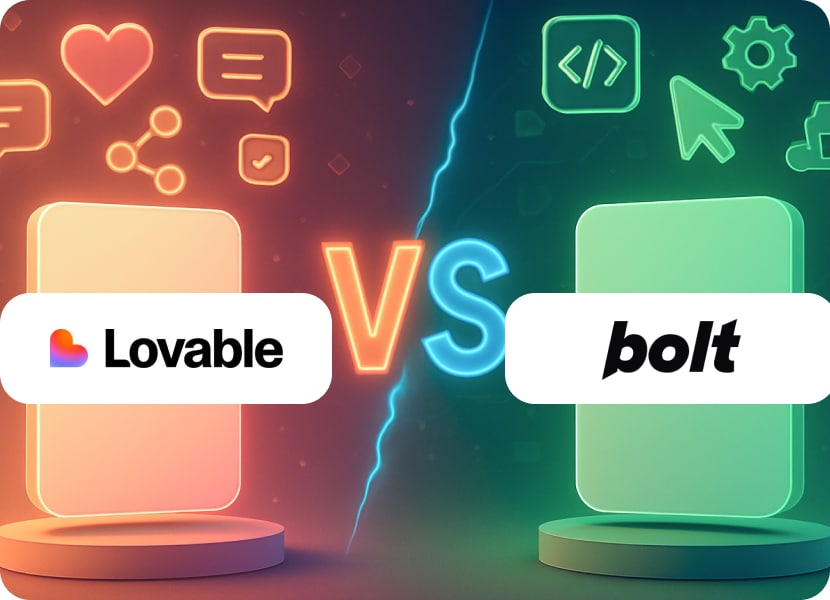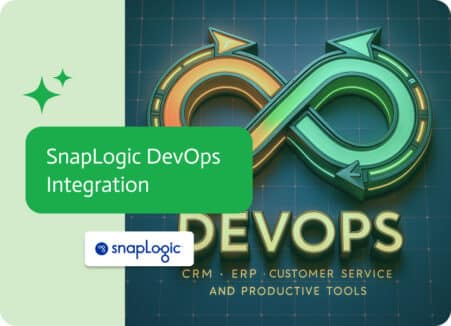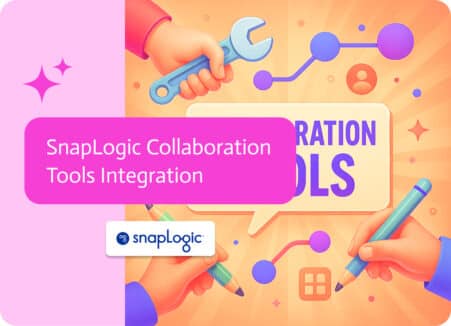

Lovable vs. Bolt: The Race to Make Apps with Vibe Coding
Something almost magical is going on right now. You sit down at your laptop, type a sentence about an app you want, and a few minutes later, you see something that works. With Lovable vs. Bolt, you don’t have to spend three hours watching YouTube videos before you can write your first line of code.
This is vibe coding, and the Lovable vs. Bolt showdown is about how people work with straightforward language to make apps that work. Both of them let you write down your ideas and see them blossom into apps, but they go about it in very different ways.
Lovable is getting close to 8 million users and is gaining a lot of steam as the preferred choice of founders who can’t code but won’t let that stop them. Bolt hit 1 million deployed websites in just five months, becoming the top playground for programmers who want to skip the boring aspects and focus on developing cool stuff.
So, which one should you pay attention to? Let’s get into this Lovable vs. Bolt discussion without all the marketing slang.
Lovable: The Secret Weapon of the Founder
Lovable lets anyone make software that is ready for production without having to know how to code, and the numbers back up that bold claim. After growing to 30,000 paying customers, the platform went from launch to $17 million in annual recurring revenue. This kind of growth would make most Silicon Valley darlings jealous.
Here’s what makes Lovable interesting: it’s genuinely built for people who don’t know React from Ruby. Lovable is an AI full-stack engineer that can build entire web applications, including front-end and back-end functionality, through conversational prompts. You’re not putting together UI parts; you’re describing a vision and watching an app come to life.
What Lovable Nails:
The vibe coding experience here is easy to get into. Lovable is different from drag-and-drop no-code tools because it focuses on generating real code. This lets developers work on frontends, backends, and database logic in just a few minutes. You’re getting actual code you can export, modify, and deploy wherever makes sense for your situation.
Lovable works with databases like Supabase and version control systems like GitHub, so you’re not stuck in a walled garden. You own the code. You can export it to GitHub, give it to a developer to improve, or keep working on it in Lovable. It’s up to you.
Lovable Cloud and Lovable AI, which use Google’s Gemini models, were just released on the platform. With Lovable AI, users can add AI features to their apps without having to set anything up, get API keys, or pay for them separately. Do you want a chatbot in your app? Just say what you want. Do you need sentiment analysis? Say what you want and watch it happen.
Where Lovable Gets Tough:
There are some problems with the vibe coding dream. To edit or deploy, you’ll need some basic development skills, and the platform has trouble with really complicated architectural needs. GitHub export gives you the most freedom, but customizing the Lovable UI in small ways might feel limited.
There’s also a learning curve around prompt engineering. It seems strange that a platform that promises to get rid of technical barriers would require you to learn how to ask for things in order to get the best results for complex applications.
Bolt: The Playground for Developers
With Bolt.new, you can enter text prompts to make a working application codebase from scratch. Then, you can add changes and change the source code in Bolt’s browser-based IDE. Bolt was made by StackBlitz, but it’s aimed at a different group of developers: those who know how to code but don’t like setting things up.
Bolt is based on StackBlitz’s WebContainers technology and gives you a full development environment where you can set up backends, install NPM packages, and connect to databases like Supabase. This is what makes Bolt different from simpler generators: you are working in a real development environment that AI speeds up.
What Bolt Does Right:
If you’re already familiar with web development, the vibe coding workflow here should feel natural. Bolt lets you use frameworks like Astro, Vite, Next.js, Svelte, Vue, and Remix right from your browser, so you don’t have to worry about setting them up.
Bolt turns plain English into full-stack apps in minutes, with no installations or steep learning curves, just pure, unadulterated creation. You don’t really need a local environment because the IDE is in the browser, so you can code from anywhere.
The platform is great for quickly creating prototypes, so Bolt is a great choice for developers who need to quickly make proof-of-concept apps or who want to make sure their ideas are good before they spend a lot of time on them.
What Bolt Does Wrong:
This is something that everyone who is thinking about using Bolt should remember. It doesn’t give the smooth development experience it promises, and it causes new problems with code generation and deployment that aren’t always easy to predict. Also, token allowances go away faster than expected.
There is friction with the token-based pricing model. Users say that when projects get bigger than simple prototypes, they run into a lot of problems, like needing a lot of tokens to debug. It looks like one developer used up 20 million tokens trying to fix just one authentication problem.
The main problem with Bolt is the “fix-and-break” cycle: these platforms fix some problems but also create new ones, which is very frustrating. This is especially painful for complicated applications that need advanced architecture.
The Lovable vs. Bolt Decision Tree
Pick Lovable when:
- You are a non-technical founder who knows exactly what your app should do.
- You need something up and running quickly without hiring developers.
- Your project fits with common types of projects, like business apps, dashboards, and MVPs.
- Vibe coding is like saying, “I tell you what to do, and you do it.”
- You can’t afford a development team because of budget limits.
- Before you put a lot of money into something, you want to make sure it’s a good idea.
Choose Bolt when:
- You already know the basics of web development.
- You want to avoid boilerplate code but still have control over the architecture.
- Your projects need certain frameworks or a high level of technical skill.
- “Help me code faster” is what vibe coding means, not “code for me.”
- You know how to debug and work with generated code without any problems.
- Rapid prototyping is more important than polishing for production.
The Hybrid Reality of Lovable vs. Bolt
The Lovable vs. Bolt landscape is starting to show a pattern: Effective teams use both, but in different ways.
People who make things use Lovable to make prototypes that they can show to stakeholders to get their feedback. The vibe coding method quickly gets working demos in front of people so they can give feedback before putting money into them.
Once ideas become clear, development teams might switch to Bolt for production builds, using their technical skills while keeping the speed of vibe coding. Or they export from Lovable and keep going in regular places.
This layered approach gets the best out of both platforms without making you choose one over the other.
Where Noca Joins the Vibe Coding Discussion
Lovable focuses on founders and Bolt on developers, but Noca takes a different approach to vibe coding: From prompt to app with enterprise orchestration and business system integration.
Noca is great when your apps need to connect deeply with existing enterprise infrastructure, like Salesforce, NetSuite, ERPs, and even old databases. Lovable might have trouble with complex integrations, and Bolt needs developers to wire everything up by hand. Noca, on the other hand, does orchestration automatically and without any effort.
Picture the landscape like this: Lovable gets people who don’t code to build. Bolt makes life just so much easier to work faster for devs. Noca makes apps that work with your current business systems and automate just about everything between them. Different strengths, but used in conjunction, are exceptionally powerful.
The Truth About Lovable vs. Bolt Users Don’t Want to Hear
Let’s be clear: Lovable and Bolt won’t be able to replace those know-it-all devs who build complex, production-ready apps. They speed things up and make things possible, but they don’t completely replace engineering knowledge.
Lovable’s main features depend a lot on third-party LLMs, so any changes in the prices, terms, or performance of those providers could directly hurt Lovable’s service or profits. There are real dependency risks to think about.
Bolt is not ideal for large-scale or production applications, with users reporting that when projects grow beyond simple prototypes, they can be quite difficult to manage. Both platforms work great in their sweet spot, but they have trouble when they go outside of it.
The Bottom Line on Lovable vs. Bolt
The comparison between Lovable and Bolt shows that both are really good vibe coding platforms, but they benefit people with different problems.
Lovable makes it possible for anyone to make apps, allowing founders and businessmen to convert ideas into working software without knowing how to code. More than half of the Fortune 500 companies are using Lovable to “supercharge creativity,” which shows that the platform is worth more than just hype.
Bolt makes developers more productive by letting them skip boring setup and tackle more interesting problems. For people who already know what they’re building, the browser-based environment and vibe coding interface make prototyping incredibly quick.
The vibe coding revolution isn’t about one platform coming out on top, but which one provides users with the suitable tools for every problem, every level of skill, and every stage of development. Both Lovable and Bolt are pushing that revolution forward, just in different directions, at different speeds, for different audiences.
FAQs
Can I really start a real business on Noca, Lovable, or Bolt?
Yes, in most cases. Sabrine’s women’s safety app built on Lovable made $456,000 in three months, and Lumoo’s app made €700,000 in seven months. These aren’t merely prototypes, as you can see, they are making money. But most successful projects eventually need developers to make them better for bigger and more complicated tasks.
Do I need to know how to code for either platform?
Lovable is made for people who don’t know how to code, and it works without them. Bolt expects you to know basic development; if you don’t, you’ll have a hard time. Lovable is like saying, “I want an app,” and Bolt is like saying, “I want to build an app faster.”
What do Bolt and Lovable really cost?
Both use pricing based on tokens or credits. Tokens that come with a plan don’t roll over every month. However, extra tokens that you buy as a reload will roll over while you are on a paid subscription. Prices depend on how much you use them, but both have free versions for trying them out.
Is it possible for me to export my code and leave either platform?
For sure. You can export code from both Lovable and Bolt and keep working on it somewhere else. You don’t have to stay within the framework, so the code is yours.
Are these tools going to take the place of developers?
No. They hasten workflows and help new creators, but complicated apps still need engineers to work on them. Vibe coding providers are what developers work on, but they don’t get rid of the technical aspects.


